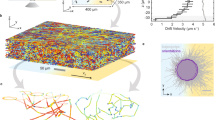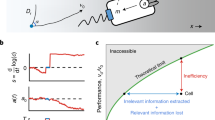Abstract
THE responses of motile bacteria to various chemicals were studied in the 1880s by Pfeffer1, who inserted a capillary tube containing a solution of an attractant into a suspension of bacteria and noted that the bacteria accumulated first near the mouth of the capillary and then inside. The assay has been developed further by Adler2,3, who measured the number of bacteria which enter the capillary in a fixed period of time. With the advent of the tracking microscope4 it has been possible to analyse responses of individual bacteria in detail5. For the analysis to be meaningful the concentration of the attractant must be known at each point in space and time. Therefore, we have solved the problem of diffusion from a small tube into a large pond. The solution also enables us to explain the general features of the Pfeffer assay.
This is a preview of subscription content, access via your institution
Access options
Subscribe to this journal
Receive 51 print issues and online access
$199.00 per year
only $3.90 per issue
Buy this article
- Purchase on Springer Link
- Instant access to full article PDF
Prices may be subject to local taxes which are calculated during checkout
Similar content being viewed by others
References
Pfeffer, W., Untersuch. Bot. Inst. Tübingen, 1, 363 (1884); ibid., 2, 582 (1888).
Adler, J., Science, 166, 1588 (1969).
Adler, J., J. Gen. Microbiol. (in the press).
Berg, H. C., Rev. Sci. Instrum., 42, 868 (1971).
Berg, H. C., and Brown, D. A., Nature, 239, 500 (1972).
Noble, B., Methods Based on the Wiener-Hopf Technique for the Solution of Partial Differential Equations (Pergamon, New York, 1958).
Carslaw, H. S., and Jaeger, J. C., Conduction of Heat in Solids, second ed., ch. 2, 9 (Oxford University Press, London, 1959).
Luikov, A. V., Analytical Heat Diffusion Theory, ch. 10 (Academic Press, New York, 1958).
Hillson, P. J., and McKay, R. B., Trans. Faraday Soc., 61, 374 (1965).
Bergmann, K., and O'Konski, C. T., J. Phys. Chem., 67, 2169 (1963).
Rabinowitch, E., and Epstein, L. F., J. Amer. Chem. Soc., 63, 69 (1941).
Author information
Authors and Affiliations
Rights and permissions
About this article
Cite this article
FUTRELLE, R., BERG, H. Specification of Gradients used for Studies of Chemotaxis. Nature 239, 517–518 (1972). https://doi.org/10.1038/239517a0
Received:
Issue Date:
DOI: https://doi.org/10.1038/239517a0
This article is cited by
Comments
By submitting a comment you agree to abide by our Terms and Community Guidelines. If you find something abusive or that does not comply with our terms or guidelines please flag it as inappropriate.



